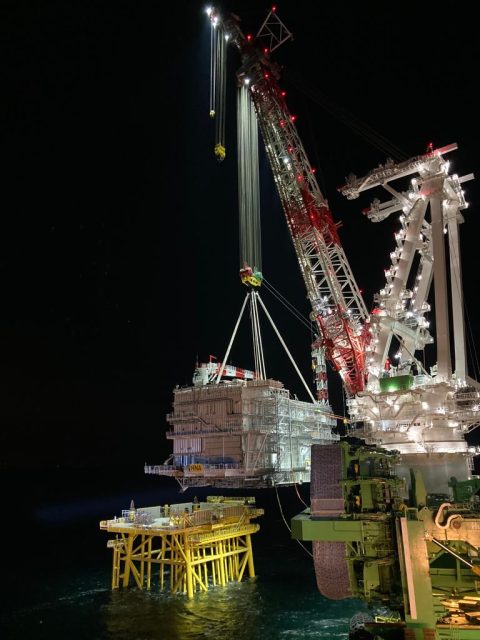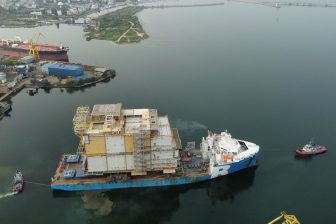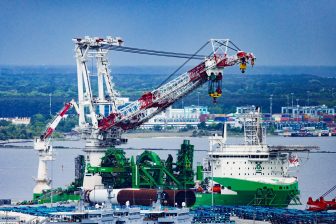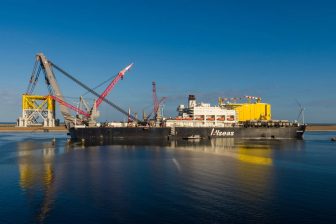
DEME’s Orion installs Hollandse Kust (north) transformer station topside
DEME’s offshore installation behemoth Orion has completed the placement of the superstructure (topside) for the offshore transformer station Hollandse Kust (north) on the chassis (jacket). This new milestone in the energy transition took place in the night from Monday to Tuesday at 18.5 kilometres off the coast of Egmond aan Zee. From 2023, TenneT will bring sustainable wind energy to land from the wind farm to be built by the Crosswind consortium (Eneco and Shell) via this ‘socket at sea’.
After a short stopover in the port of IJmuiden, the topside arrived at its destination from Hoboken (Antwerp) in Belgium on Monday. “We had to wait until the installation vessel Orion was available and the weather and tidal conditions offered us a favorable time window”, says Guus Siteur, project leader offshore platforms on behalf of TenneT.
Since November last year, the jacket has been firmly anchored to the seabed. Installing the topside went relatively quickly, according to Siteur. “A large crane on the Orion lifted the 3,500-ton steel construction from the floating pontoon. So-called cones are attached to both the jacket and the topside . You can compare these to ice cream cones that fit together perfectly. This way you can lower the topside exactly in the right place,” he said.
The topside is the upper part of the transformer platform. It is a construction of 47 meters long, 35 meters wide and 25 meters high.
Welding together
Later, a jack-up barge (lifting vessel) was placed at sea next to the socket. This lifting vessel is a workshop and a hotel at the same time. “When the latter has extended its legs and the ship hangs above the waves like a plateau, a footbridge is suspended between the ship and the platform. About fifty people will be staying on the ship in the coming months. They weld the topside to the jacket and take care of the commissioning of the installation,” Siteur said.
Tennet testing
Next month, TenneT will also test the fiber optic connection, which was laid together with the sea cables. It can then be used to control the unmanned socket at sea. “Everything will soon be controlled from our operations center in Arnhem. In addition to the transformers that bring the voltage level from 66 kilovolts to 220 kilovolts for efficient transport, there is also 130 kilometers of cable in the topside to connect all systems,” noted Siteur.
Sea cables and Maritime Information Service Points
The sea cables for ‘north’ are already laid out in the seabed. Behind the dunes at Heemskerk/Wijk aan Zee, these will be linked to the cables that will soon feed the power into the high-voltage substation along the A9 in Beverwijk. In the coming weeks, the cables for (west Alpha) will also be laid at a safe depth in the seabed.
Each TenneT power socket at sea is used as a ‘Maritime Information Service Point’ for Rijkswaterstaat. This monitoring station consists of radars, meteorological systems (for wind, precipitation, clouds and temperature) and ecological monitoring systems for birds and bats, for example. Siteur: “Biological huts are attached to the legs of the jacket to create breeding grounds for fish. And structures will be placed on the stone subsoil where marine life can nestle safely.”
One down, two to go
In total, the EQUANS/Smulders combination is building three topsides for TenneT. After ‘north’, ‘west Alpha’ will follow in 2023 and ‘west Beta’ in 2025. From the wind farms of the same name, the grid operator will make sustainably generated electricity available to households in the coming years via these sockets (together good for 2.1 gigawatts). companies and industry.
You just read one of our premium articles free of charge
Register now to keep reading premium articles.




